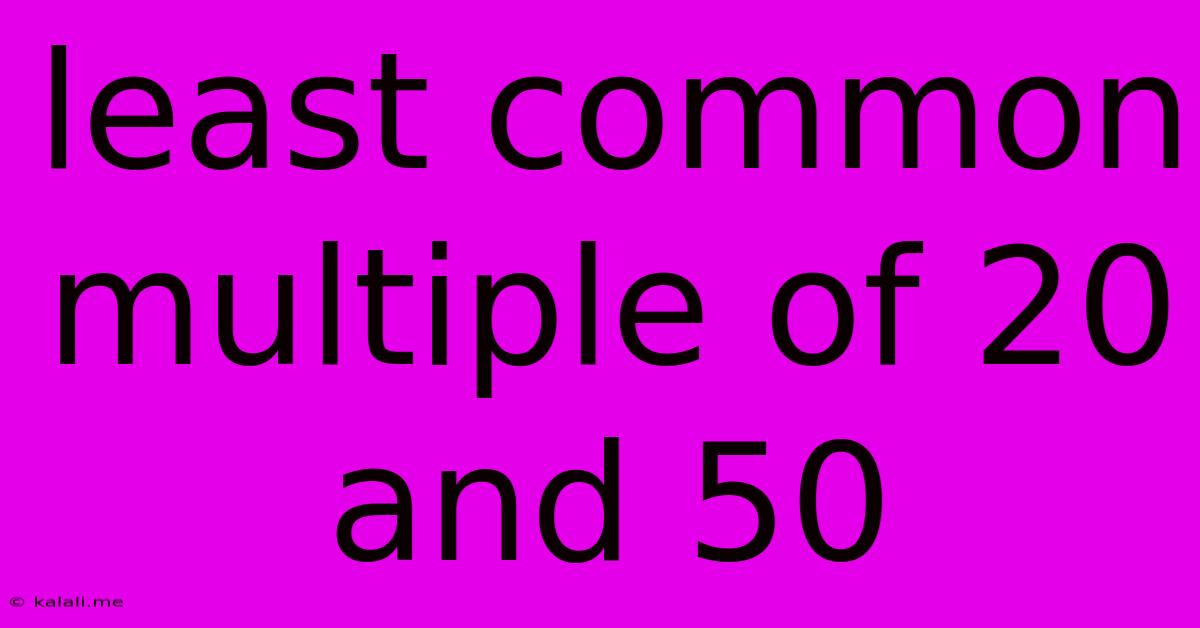Least Common Multiple Of 20 And 50
Kalali
Jun 15, 2025 · 3 min read

Table of Contents
Finding the Least Common Multiple (LCM) of 20 and 50: A Step-by-Step Guide
Finding the least common multiple (LCM) is a fundamental concept in mathematics, particularly useful in simplifying fractions and solving problems involving cycles or periodic events. This article provides a comprehensive guide on how to calculate the LCM of 20 and 50, exploring different methods and explaining the underlying principles. Understanding LCMs is crucial for various mathematical applications and enhances your problem-solving skills. This guide will make calculating LCMs, like finding the LCM of 20 and 50, simple and straightforward.
Understanding Least Common Multiple (LCM)
The least common multiple (LCM) of two or more integers is the smallest positive integer that is divisible by all of the integers. In simpler terms, it's the smallest number that both numbers can divide into evenly. This is different from the greatest common divisor (GCD), which is the largest number that divides both numbers evenly. Mastering both concepts is key to efficient number theory calculations.
Method 1: Listing Multiples
This method is straightforward, especially for smaller numbers like 20 and 50. We list the multiples of each number until we find the smallest multiple common to both.
- Multiples of 20: 20, 40, 60, 80, 100, 120...
- Multiples of 50: 50, 100, 150...
The smallest number appearing in both lists is 100. Therefore, the LCM of 20 and 50 is 100. This method is effective for smaller numbers but becomes less efficient for larger numbers.
Method 2: Prime Factorization
This method is more efficient for larger numbers and provides a more systematic approach. It involves finding the prime factorization of each number and then constructing the LCM from the highest powers of all prime factors present.
-
Find the prime factorization of 20: 20 = 2² × 5
-
Find the prime factorization of 50: 50 = 2 × 5²
-
Identify the highest power of each prime factor:
- The highest power of 2 is 2² = 4
- The highest power of 5 is 5² = 25
-
Multiply the highest powers together: LCM(20, 50) = 2² × 5² = 4 × 25 = 100
Therefore, the LCM of 20 and 50 using prime factorization is 100. This method is generally preferred for its efficiency and systematic approach, particularly when dealing with larger numbers or multiple numbers.
Method 3: Using the Formula (GCD and LCM Relationship)
There's a relationship between the greatest common divisor (GCD) and the least common multiple (LCM) of two numbers, 'a' and 'b':
LCM(a, b) = (a × b) / GCD(a, b)
First, we need to find the GCD of 20 and 50. Using the Euclidean algorithm or prime factorization, we find that the GCD(20, 50) = 10.
Now, we can apply the formula:
LCM(20, 50) = (20 × 50) / 10 = 1000 / 10 = 100
This method confirms that the LCM of 20 and 50 is indeed 100. This approach is particularly useful when the GCD is easily calculated.
Conclusion
We have explored three different methods to find the least common multiple of 20 and 50. All methods confirm that the LCM is 100. Choosing the best method depends on the numbers involved; the listing method is suitable for smaller numbers, while prime factorization and the GCD-LCM relationship are more efficient for larger numbers. Understanding these methods strengthens your mathematical foundation and problem-solving abilities. Remember that mastering LCM calculations is essential for various mathematical applications, from fraction simplification to more advanced mathematical concepts.
Latest Posts
Latest Posts
-
List Of Sports Cups And Trophies
Jun 15, 2025
-
Bank Account Closing Letter Word Format
Jun 15, 2025
-
The First Five Multiples Of 9
Jun 15, 2025
-
What Is The Factor Of 112
Jun 15, 2025
-
Difference Between Electron Affinity And Electronegativity
Jun 15, 2025
Related Post
Thank you for visiting our website which covers about Least Common Multiple Of 20 And 50 . We hope the information provided has been useful to you. Feel free to contact us if you have any questions or need further assistance. See you next time and don't miss to bookmark.